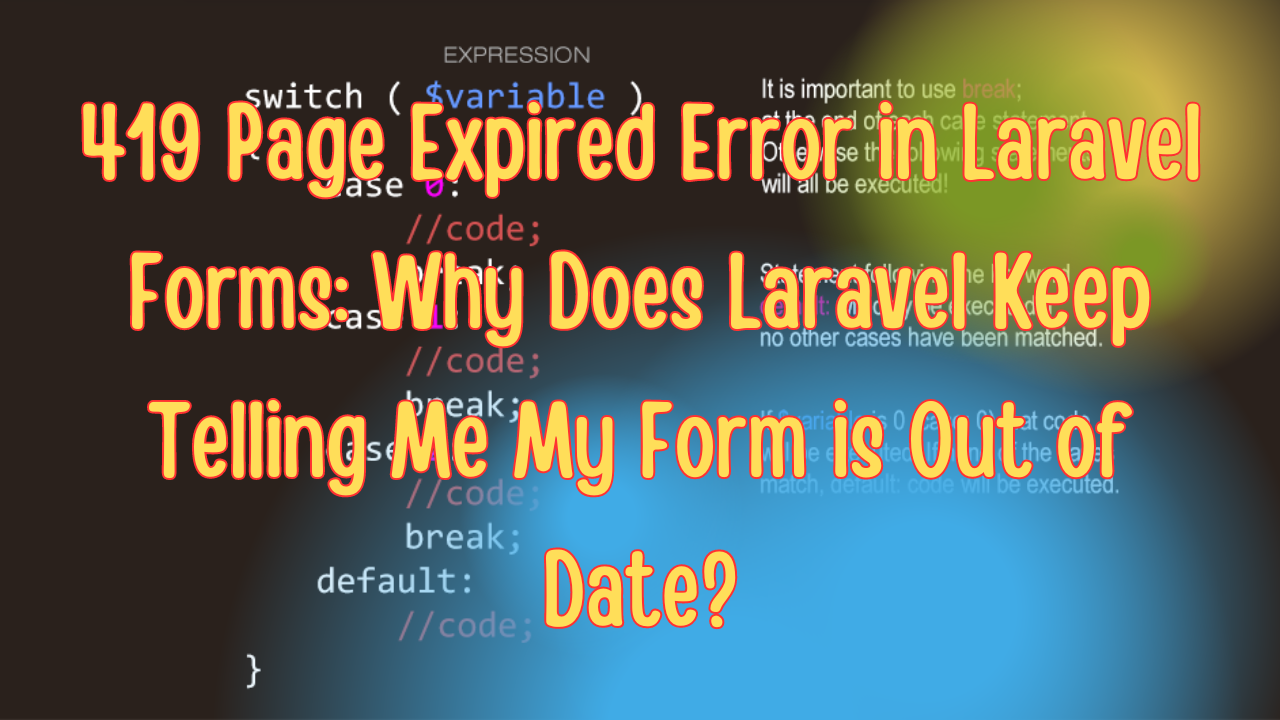Ah, the 419 error in Laravel. If you’ve ever hit “submit” on a form only to be greeted with a “Page Expired” message, you know the frustration. It’s like Laravel is politely telling you, “Sorry, this page is as outdated as a flip phone.” But don’t worry, I’m here to help you decode this error and fix it with a smile (and maybe some sarcasm).
What’s Up with the 419 Page Expired Error?
Let’s break it down: The 419 status code is Laravel’s way of saying that your CSRF token has either gone stale or is missing entirely. It’s Laravel’s defense mechanism, making sure that only legitimate requests can be processed by your app. In other words, Laravel is trying to protect you from hackers, but sometimes it overdoes it, like a protective parent putting a leash on their kid.
Common Causes of the 419 Error (AKA Laravel’s Drama Moments)
-
Missing CSRF Token in Forms: This is probably the most common reason. Forgetting to add
@csrfin your form is like forgetting your umbrella on a rainy day—you’ll get drenched with errors.<form method="POST" action="/submit-form"> @csrf <!-- Your input fields --> <button type="submit">Submit</button> </form> -
Session Timeout: Laravel, much like us, has an expiration date for things. If your session expires, the CSRF token will too. Think of it like milk in your fridge—keep it too long, and it goes bad.
-
Caching the Blade Templates: If you’re caching Blade views, Laravel might be serving an old form with a stale CSRF token. It’s like using yesterday’s password when you’ve already changed it.
-
AJAX Requests Without the CSRF Token: If you’re submitting forms via AJAX and forgetting to include the CSRF token, Laravel will slam the door in your face like an annoyed teenager.
$.ajaxSetup({ headers: { 'X-CSRF-TOKEN': $('meta[name="csrf-token"]').attr('content') } }); -
Browser Back Button Woes: Sometimes users hit the back button and resubmit a form. Laravel sees the old, expired token and thinks, “Hey, this doesn’t look right!”—and out comes the 419 error.
Fixing the 419 Error (Or, How to Keep Laravel Happy)
Now that we know what’s causing the issue, let’s fix it with some simple (but effective) strategies.
-
Always Include the CSRF Token in Forms
Laravel gives you the
@csrfBlade directive for a reason—use it! It’s like adding a seatbelt to your form, keeping it safe and secure.<form method="POST" action="/save-data"> @csrf <!-- Form fields --> <button type="submit">Submit</button> </form> -
Handle Session Expiration Gracefully
If your session expires too quickly, users might run into the 419 error when submitting forms. Extend your session’s lifetime in
config/session.php:'li---
Keywords: Laravel 419 Page Expired, CSRF Token Expired Laravel, Laravel form submission error, Laravel session timeout issue, fix 419 error in Laravel
This blog blends humor with practical advice, making it SEO-friendly while engaging readers!fetime' => 120, // Increase as needed ```
-
Clear Cached Views
If you’ve been caching views, Laravel might be holding onto old forms with expired CSRF tokens. Clear your view cache like this:
php artisan view:clear -
Include the CSRF Token in Your AJAX Requests
Don’t forget that AJAX requests need CSRF protection too. Add the token to your request headers:
$.ajaxSetup({ headers: { 'X-CSRF-TOKEN': $('meta[name="csrf-token"]').attr('content') } }); -
Handle Browser Back Button Submissions
If users are likely to hit the back button and resubmit forms, consider redirecting them to a fresh page after form submission. This way, Laravel won’t throw a fit when they try to resubmit with an expired token.
return redirect()->route('form.success')->with('status', 'Form submitted successfully!');
Extra Debugging Tips (When Laravel’s Still Being Stubborn)
- Check Your Cookies: The CSRF token is stored in a cookie, so make sure it’s being sent and received properly.
-
Enable Debugging: Laravel’s debug mode can reveal hidden issues, so crank it up in
config/app.php.
Conclusion
The 419 Page Expired error can be a bit of a diva, popping up when you least expect it. But now that you know what’s causing it and how to fix it, you can avoid these awkward encounters. Just remember to keep your CSRF tokens fresh, manage session lifetimes, and don’t forget to clear your caches.
The next time Laravel tells you your page has expired, instead of panicking, just smile, take a deep breath, and say, “Not today, Laravel. Not today.”
I hope this guide was helpful—and maybe gave you a chuckle or two. Happy coding!




